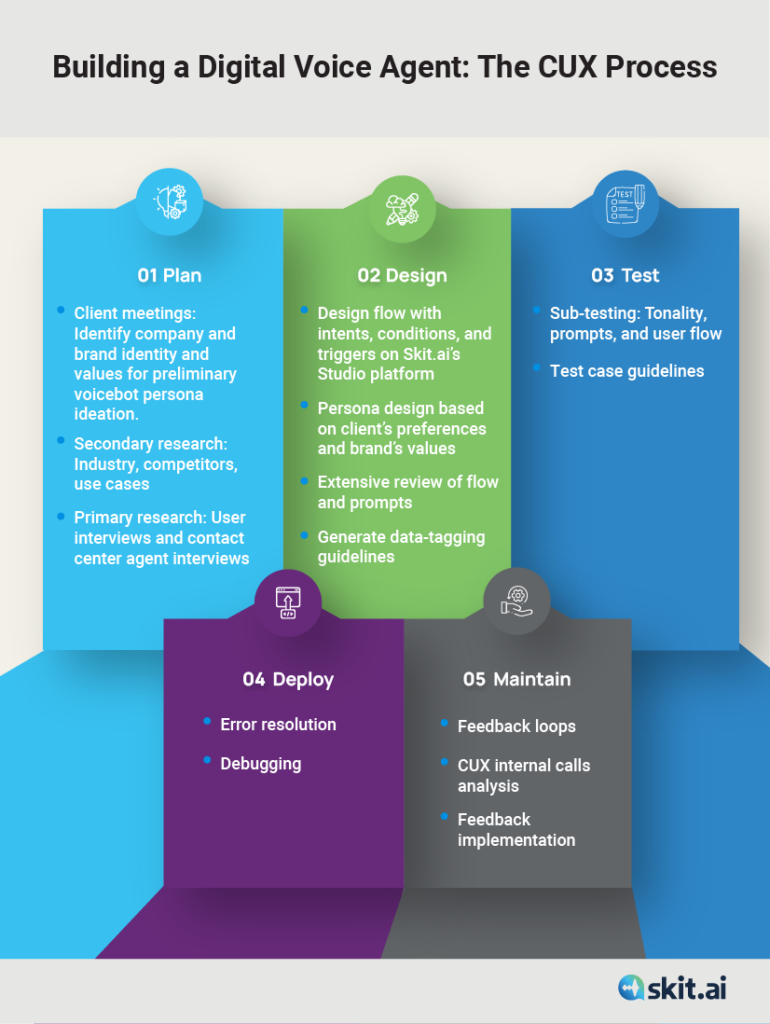Parika Bhatli
February 1, 2023

Hello! Welcome to Skit.ai. Click here to book a demo.
When building any product, solution, or interface, you want the end result to be as user-friendly as possible. To achieve this, companies typically conduct a thorough background research of the product’s prospective users. That’s where User Experience Research comes into play.
User Experience Research (UXR) is the study of target users, their behavior, and their needs; this multi-step process enhances the design process with a user-centric approach.
A Conversational Voice AI solution — i.e. a voicebot — is no different. Skit.ai relies on a team of CUX (Conversational User Experience) designers and UX researchers to build its Digital Voice Agents for new clients and use cases. In this article, I’ll walk you through the research process required to build a Digital Voice Agent.
Building the Conversational User Experience for a Digital Voice Agent typically involves five main steps: planning, design, testing, deployment, and maintenance. In the table below, you can see the different steps and the sub-steps they involve:

How does the research process work? First of all, the CUX researcher meets with the client, the Solutions Product Manager, and the CUX designer. Together, they identify the company and brand’s values for a preliminary persona ideation of the voicebot. More on that later.
The researcher conducts in-depth research on the client’s industry, the use cases (or functions) that the Digital Voice Agent will need to address and help customers with, and the target audience the voice bot will cater to.
Additionally, the researcher conducts a competitor analysis to assess the existing landscape, the competitors’ offerings, and their target audiences. For example, the researcher might look into which FAQs are addressed by the competitors’ offerings. Through the competitive analysis, the researcher might identify windows of opportunity and help the client gain a competitive edge.
At this stage of the process, the researcher conducts interviews with both internal and external stakeholders. Internal stakeholders are team members currently working for our company, while external users are usually customer service agents who operate in a specific industry or company; these often include the client’s live agents.
The researcher usually interviews the client’s top-performing agents to get insights into their approach and techniques. The agents are asked to solve some example scenarios, provide a process view of their call flow, and share any insights they have gathered from their experience.
Through this round of interviews, the researcher seeks to learn more about the client’s product or solution, the frequently asked questions (FAQs), and what makes a call successful. Any call data analyses that the client can provide are helpful, too.
At the end of this step, the researcher usually gathers all of the findings in a comprehensive, data-based analysis.
Every company has its own voice, and therefore every company deserves a custom-made voicebot. The Digital Voice Agent can also be tailored to the company’s voice and brand, as it will inevitably become another expression of the brand itself.
The persona design is not always performed, but it’s often an essential part of the design process. It involves shaping the bot persona around the company’s values and brand identity, which are expressed through the way the voicebot communicates and interacts with the consumers.
Another important aspect of the research process is the study of the users that will ultimately be interacting with the Digital Voice Agent. This step is essential for the CUX Designer to be able to create useful and meaningful conversation flows for the voice bot.
User flows are diagrams used by designers to understand the patterns users may take when interacting with the voicebot. User flows will change significantly depending on the use case and the customer’s needs. User flows are usually granular and detailed.
The user journey is a more macro view of the user experience during the interaction with the voicebot.
User behavior depends on the audience that the company commissioning the Voice AI solution is targeting. With thorough user research, the CUX researcher aims to understand the users’ behavior, needs, and the approach they typically prefer. Studying user behavior helps researchers and writers make the solution more user-friendly.
The team creates user personas and dialogued interactions in order to see how each user is likely to interact with the Digital Voice Agent. For example, one user persona could be Jane, a 33-year-old entrepreneur and micro-influencer who lives in Green Point, Brooklyn. Three years ago, Jane took a loan to launch he
custom embroidery t-shirt brand. Today, Jane receives a call from the Digital Voice Agent on behalf of a collections agency about her overdue loan. The designer will draft a sample conversation between Jane and the voicebot.
User Experience Research is just the beginning of the process. These research insights are then converted to meaningful design actionables. Design and testing follow, with deployment completing the process.
Are you curious to learn more about Voice AI and its applications across various industries and use cases? Check out our blog!
The auto finance industry is experiencing significant transformations driven by market dynamics, consumer behavior, and technological innovations. Here are the key trends shaping the future of auto finance, focusing on the implications for Buy Here Pay Here (BHPH) dealers and the role of Conversational AI and contact center automation in streamlining operations, which will help […]
The auto finance industry, a crucial pillar in the automotive market, experienced a turbulent Q2 in 2024. The rise of delinquent accounts in subprime lending has become a significant concern for industry stakeholders. Subprime lending, which targets borrowers with lower credit scores, is inherently riskier, and recent economic pressures have worsened these risks. This blog […]